What Colour is my Hamster?
From Hamster Central WIKI
By forum members Souffle and Pophammy
So you have a new hamster? People inevitably ask you first of all: ‘What colour is it?’ You will probably say ‘Well, it’s sort of brown or grey or spotty or fluffy!’. Did you know that all hamsters have a colour, pattern and fur type which is recognised by the various hamster authorities around the world? In this article we hope to be able to help you identify your hamster’s colour and type and say with confidence exactly what you have.
Let’s start with the Syrian Hamster
Firstly we will look at the colour of the hamster’s coat. The basic colours can be divided into two groups; the Agouti types and the Self types.
Agouti
An agouti hamster is not the same colour all over. If you look at the tummy fur it will be paler than the fur on the back of the animal. It will also have pale coloured crescents of fur running above and below a darker cheek flash (the dark stripe) and a band of darker fur running across its chest. Often if you look at each hair by blowing on the coat you will see that each hair has a dark base colour then a stripe of top coat colour and sometimes the hair is ticked with a dark tip at the end of the hair. Examples of Agouti hamsters commonly seen are Golden, Cinnamon, Yellow, Silver Grey and Honey. There are more colours which are less commonly seen.
An Agouti hamster - Golden

The fur on a golden showing colouring

Self
A self coloured hamster has the same colour over the whole body and does not have cheek flashes or a paler tummy. Usually each hair is the same colour to the roots, though there are a few exceptions where there is an undercoat present and this is usually paler than the top coat. Often self coloured hamsters will have a little patch of white on the chin or on the feet like little socks. Examples of self coloured hamsters are Black, Cream, Sable and White.
A Self coloured hamster - Cream

Having now established if your hamster is an Agouti type or a Self type in colour we can now bring pattern into the picture. There are four types of pattern commonly found.
Dominant Spot
A dominant spot hamster will look like a white hamster with spots of coloured fur all over. Often the spots are not evenly distributed but if your hamster has any spots on a white body it is likely to be a dominant spot. The spots can be any colour. There is also a type called Piebald which is a coloured animal with white spots but these are very rare as they are notoriously difficult to breed.

Banded
A Banded hamster has the appearance of a coloured hamster with a band or belt of white running around the middle of its body. Frequently the band is found to be crooked or have blotches of colour in the white area as it is very hard to breed a perfect band! If your hamster has a coloured head and rear end with a white bit in the middle it will be banded.


Tortoiseshell
A tortoiseshell hamster will have two colours of fur distributed in a pattern of blotches across its body. The colours will be a main colour plus its corresponding yellow colour. For example a golden tortoiseshell would have rich apricot yellow and cinnamon would have honey blotches. Sometimes brindling and mixing of the colours appear and often one colour is very dominant, but if there is even only one splash of yellow in a coloured hamster, it is a tortoiseshell. Because it is a sex-linked gene, tortoiseshells are always female. Tortoiseshell can also be combined with dominant spot or banded to produce a three coloured hamster called a Tortoiseshell and White or a Tricolour in the USA.
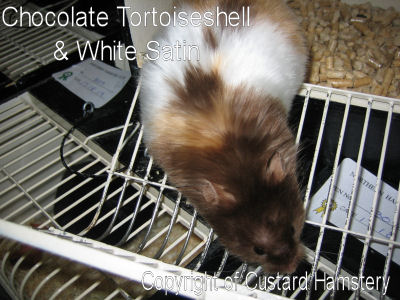
Roan
A roan hamster is a white hamster which is ticked all over with colour. The ticking is heavier on the head. This means that each hair is white but the end has a tip of colour on it. The ticking can be in any colour for example chocolate or black roan.

Coat Type
There are four types of coat type or fur found in the Syrian hamster – Short hair, Long hair, Satin and Rex.
Short hair
A short haired hamster has short, dense almost velvety fur all over the body.

Long Hair
When young, long haired hamsters tend to look quite fluffy, but sometimes, it can be hard to tell. However when mature the fur will be soft, very dense and fairly long over the whole body. Females and males usually both have little, long tufts growing from behind the ears and the scent glands and males only, develop a very long ‘skirt’ around the whole rear end. This can grow up to about 10cm in length. Females may have a ‘mini skirt’ but it never grows as long as the males.
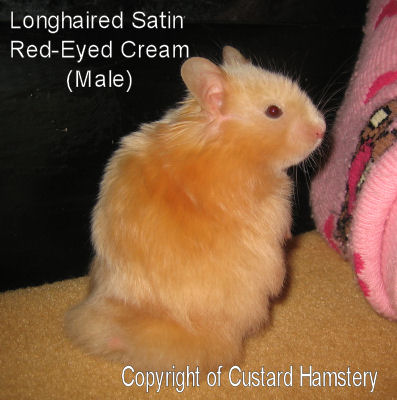
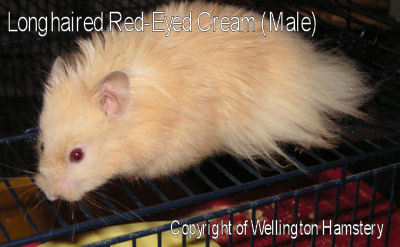

Satin
The satin hamster can be either short haired, long haired or rex but in all cases the fur will be dense and have a glossy, satin sheen. Satin hamsters can be hard to photograph due to the shiny fur. Satin can be combined with any colour.

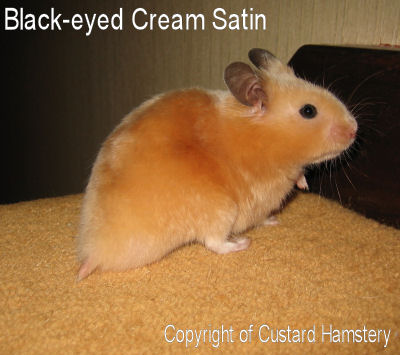
Rex
Rex hamsters are fairly uncommon. A rex hamster can be any colour and can be long haired or satin, but the fur will be soft and dense and will have a ‘frizzy’ appearance. Your hamster may look as if he has curls or waves in his fur! The whiskers in a rex are curly making them easily identifiable.

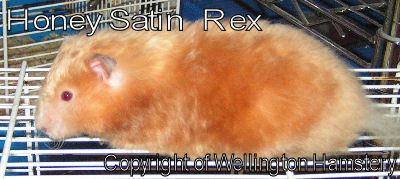

Eye and Ear Colour
Each colour has a corresponding matching eye colour ranging from black to a bright clear pink. Occasionally a patterned hamster may have odd coloured eyes. Colours also have corresponding ear colours ranging from black to pale pink, and in patterned hamsters the ears can be blotchy with mixed skin colours.
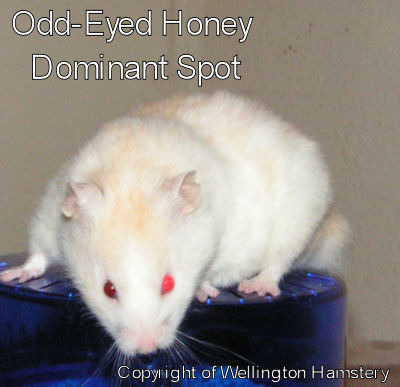
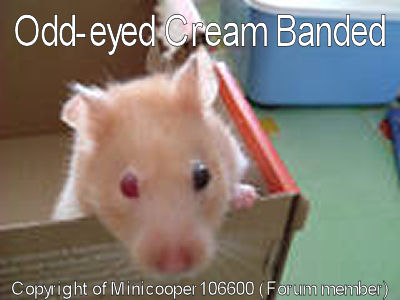
Umbrous
Some hamsters have a gene called Umbrous. This makes the hamster look sort of sooty all over, as if it had been rolling in ash.
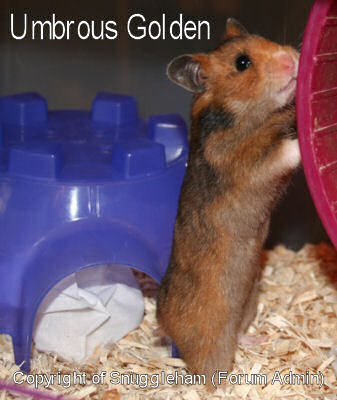
Here are some examples of commonly found hamster types. Hopefully by comparing your hamster with these pictures you will be able to identify your hamsters colour and coat type. Hamsters like all species do not always conform exactly to the standard and some hamsters may just be a bit of a ‘Heinz’ variety or even a new colour! They are all beautiful in their own way and please bear in mind that coat colour changes throughout life so consider the age of the animal you are looking at. In general light animals such as cream will deepen and become richer with age where as dark coloured hamsters such as black will tend to fade and become more browny or grey as they get older. If you have any problems please feel free to post a picture of your hamster and we will do our best to identify the colour.
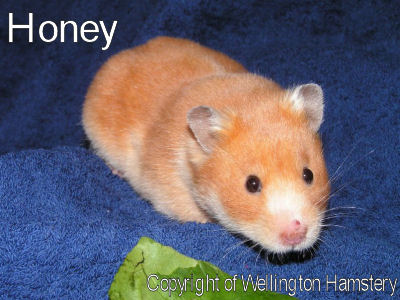
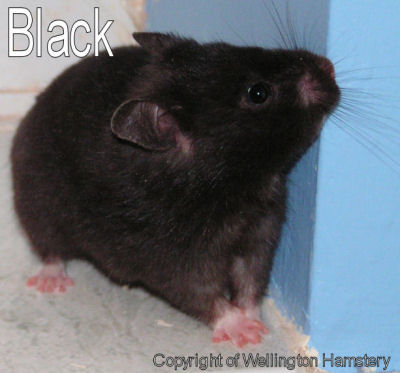


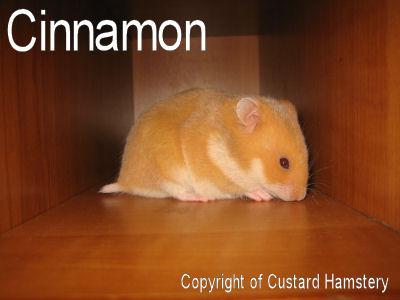
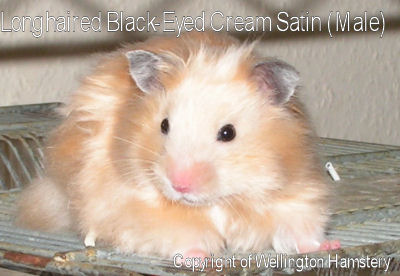
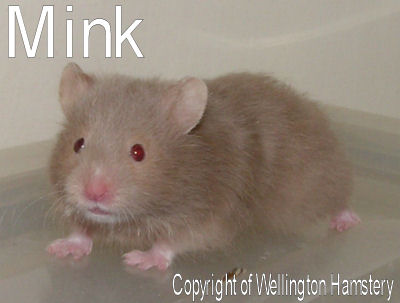
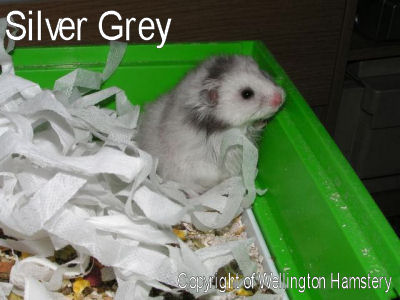

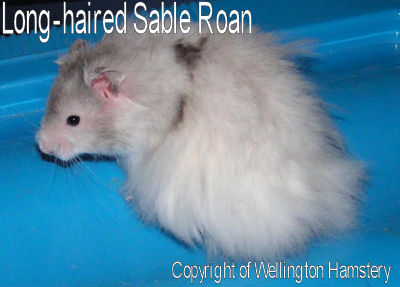
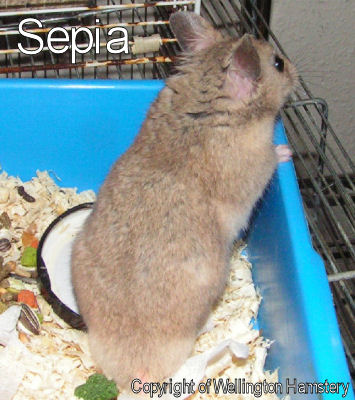
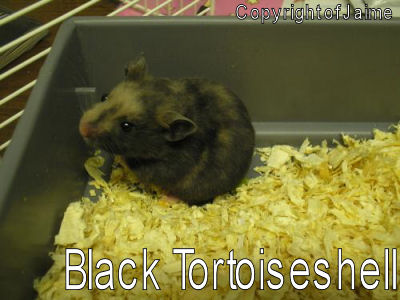
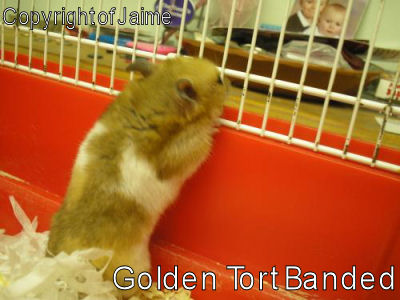

We would like to thank the people who allowed us to use their photographs in this article, in particular, PJ of Wellington Hamstery, Gemma Pickering, Jaime, Minicooper106600 and Snuggleham of www.hamstercentral.com. If you have a hamster of known colour not already covered please feel free to email it to [email protected] for inclusion in the gallery.

